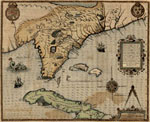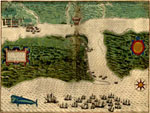Spain laid claim to the region from Florida to the Chesapeake Bay, but never effectively controlled this vast area in its entirety. Spain faced competition from other European powers, notably France and England. French Huguenots established Fort Caroline in Florida near the mouth of the St. Johns River in 1564. One objective of Pedro Menéndez de Avilés’1565 expedition was to eliminate French settlements in Florida from which the French could threaten the treasure ship fleets. Menéndez de Avilés attacked the French garrison, burned the settlement, and slaughtered all its inhabitants.
In 1585-86 Sir Francis Drake (ca. 1540-1543-January 28, 1596) made raids on behalf of the English on various communities in Florida and the Caribbean, including St. Augustine, Santiago de Cuba, Santo Domingo, and Cartagena. St. Augustine was looted and burned. England later established colonies in Georgia and North Carolina. In 1702 the English again sacked St. Augustine and destroyed the Spanish missions in northern Florida.
The dramatic voyage of René-Robert Cavelier, Sieur de La Salle (1643-1687) down the Mississippi River to its mouth and the French claim to an immense territory it named "La Louisiane" shocked the Spanish. Prior to that voyage, the area along the Gulf Coast had been considered exclusively Spanish territory. The Spaniards mounted a series of expeditions into east Texas in search of French encroachments on Spanish territory.
La Salle supposedly had built a Fort St. Louis in Texas, but it was destroyed by Karankawa Indians. In 1689 one of the Spanish expeditions reported that they had found the remains of the fort and rescued French children--four brothers and a sister--from nearby tribes. Still, by the early 18th century, France had established settlements along the Gulf Coast at Mobile, Biloxi, and New Orleans to strengthen its original claims.
In 1762 France ceded Louisiana to Spain, which in turn ceded most of Florida to England in exchange for the recently captured Havana. The Spaniards later fought alongside the Americans during the Revolutionary War, but the rapid growth of the new United States rendered Spain’s presence in North America increasingly precarious. Don Bernardo de Gálvez’s victories in Mobile and Pensacola drove the British out of Spanish West Florida. By 1813, however, Spain controlled only the Pensacola area of west Florida. In 1821 Andrew Jackson formally accepted the cession of the remaining part of Spanish Florida to the United States.
1. Amerigo Vespucci (1452-1512), a Florentine navigator, undertook voyages for Spain and Portugal. His writings were widely circulated in Europe in the early 1500s, which helps to explain why the German mapmaker Martin Waldseemüller (ca.1470–ca.1518) called the New World “America” in his famous 1507 map.
2. French contacts with the Timucua peoples of what is now northern Florida were documented by Jacques Le Moyne. Here, the alliance of the French with Chief Outina is used to overwhelm his archenemy Potanou. Further French and Spanish struggles are described in the presentation France in America, especially in the section on The Struggle for Pensacola.
3. It is possible that this map was produced, at the request of Spain, by Antoine Perrenot de Granvelle (August 20, 1517-September 21, 1586), Spanish negotiator with the French and English for the 1559 Treaty of Cateau Cambrésis. Further details are described in the American Memory special presentation essay in the section on The 1562 Map of America by Diego Gutiérrez.
4. The French artist Jacques Le Moyne visited Fort Caroline in 1564 and later produced this early map of Florida.
5. Spain’s claims to large parts of what later became the southeastern United States were based in part in de Soto’s journey, as shown in this Spanish map of 1742. Arredondo sought to demonstrate that the British colony of Georgia was illegally sited on Spanish territory. In the 16th century, Spain considered Florida a geographic entity which extended north to the Chesapeake Bay and west beyond the Mississippi River, as can be seen in Arredondo's map.
6. In 1585-86 Drake made raids on various communities in the West Indies, including St. Augustine, Santiago de Cuba, Santo Domingo, and Cartagena. Baptista Boazio (fl.1588), an Italian artist resident in London, made engravings of the attacks on each city, from drawings possibly obtained from Drake himself.
7. Don Bernardo de Gálvez won victories in Mobile and Pensacola that drove the British out of Spanish West Florida.
Anthology of miscellaneous materials in the Italian language, Amerigo Vespucci et al. [Florence, third quarter of the 16th century]. Item 1, 1 leaf. Collection of Spanish American documents of Hans Peter Kraus. Manuscript Division. Library of Congress. (1)
Outina over Potanou. Photoreproduction from La Floride française, scène de la vie indienne, peintes en 1564. Theodor de Bry and Charles de la Roncière. [facsimile of the 1564 original (Paris, 1928)]. Rare Book and Special Collections Division. Library of Congress. (2)
Americae sive quartae orbis partis nova et exactissima descriptio [North and South America]. Diego Gutiérrez. 1562. Geography and Map Division. Library of Congress. (3)
Floridae Americae provinciae recens & exactissima descriptio auctorè Iacobo le Moyne cui cognomen de Morgues… [Map of Florida…]. Le Moyne. [1591]. Geography and Map Division. Library of Congress. (4)
Demostracion historiografica del derecho que tiene el Rey Catholico…, [Historiographic demonstration of the rights of His Catholic Majesty…. Antonio de Arredondo]. 1742. Collection of Spanish American documents of Hans Peter Kraus. Manuscript Division. Library of Congress. (5)
St. Augustine [Hand-colored engraved map]. 1586. Rare Book and Special Collections Division. Library of Congress. (6)
Diario de las operaciones de la expedicion contra la Plaza de Panzacola. [Operational Diary of the Expedition against Pensacola]. Don Bernardo de Gálvez. [1781?]. Rare Book and Special Collections Division. Library of Congress. (7)







